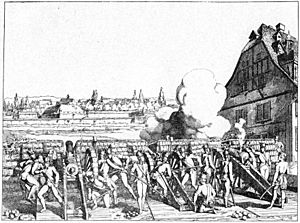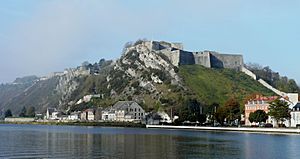Reduction of the French fortresses in 1815 facts for kids
Quick facts for kids Reduction of the French fortresses in 1815 |
|||||
|---|---|---|---|---|---|
| Part of The Waterloo Campaign | |||||
 Rocroi seen from the air shows its defensive structure. |
|||||
|
|||||
| Belligerents | |||||
| Seventh Coalition | |||||
After Napoleon lost the Battle of Waterloo in June 1815, armies from many countries (called the Coalition) marched towards Paris. As they moved through France, they captured some towns and fortresses. However, they also left many behind, sending smaller groups to watch and eventually take them over. The very last French fortresses did not surrender until September of that year.
Contents
Taking Over French Fortresses
After the big battle, the Coalition armies needed to secure the areas they had conquered. This meant taking control of important French fortresses. These strongholds were like giant castles, built to protect the country.
Fortresses in the North
By June 21, 1815, the armies led by Prince Blücher and the Duke of Wellington reached a special defense line. This was called the Triple Line of Fortresses. Before 1814, many military experts thought these forts were impossible to get past.
It was very important for the Coalition to capture some of these main fortresses. They needed these forts as new bases to plan their next moves deeper into France. The first ones they decided to surround were Valenciennes, Le Quesnoy, and Cambrai. These were blockaded by the British and their allies. The Prussian army blockaded Maubeuge, Landrecy, Avesnes-sur-Helpe (Avesnes), and Rocroi.
On June 23, 1815, the commanders met at Catillon. They discussed how to besiege the fortresses and plan their future operations. They agreed that capturing some forts right away was key to their advance.
They also decided that Prince Frederick of the Netherlands's troops would stay behind. Their job was to besiege forts near the Scheldt river. Other German forces, led by Prince Augustus of Prussia, would besiege forts near the Sambre and Moselle rivers. This included the Prussian II Corps and the North German Corps.
A special Coalition force, also led by Prince Augustus of Prussia, helped capture the forts left behind by the main British and Prussian armies. They used a powerful British Battering Train (large cannons) to help break down the walls.
Here's a list of some northern fortresses and when they surrendered:
| Fortress | Start of Siege | Surrender Date |
|---|---|---|
| Maubeuge | July 8 | July 12 |
| Landrecies | July 19 | July 21 |
| Mariembourg | July 27 | July 28 |
| Philippeville | August 7 | August 8 |
| Rocroy | August 15 | August 16 |
Prince Augustus was ready to start attacking Charlemont and its nearby forts (Givet and Mont d'Hours) on September 8. But the French commander, General Burke, saw that his forces would be too spread out. So, he started talks and surrendered those smaller forts on September 10. He moved his troops into Charlemont. The bombardment of Charlemont was supposed to start on September 23. However, on September 20, Prince Augustus learned that fighting was to stop all over France.
Fortresses in the East
Just like the armies of Wellington and Blücher, the Austrian-allied Army of the Upper Rhine also moved past many fortresses as they entered France. When they heard that Paris was captured and fighting had stopped, they included several eastern fortresses in the ceasefire. These included Strasbourg, Landau, La Petite-Pierre, Sélestat, Lichtenberg, Phalsbourg, Neuf-Brisach, and Belfort.

One fortress that did not surrender easily was Huningue. Its governor, General Barbanègre, commanded only 500 men. They faced 25,000 Austrian soldiers. On June 28, even after Napoleon had given up his power and the French government asked for a ceasefire, General Barbanègre ordered his troops to bomb the nearby Swiss city of Basel. People on the Coalition side thought this was a serious war crime. When Huningue finally surrendered on August 26, 1815, the city was in ruins. Its fortifications were torn down as part of the Treaty of Paris (1815), because Basel had asked for it.
What Happened Next
After all the fighting, a new Treaty of Paris (1815) was signed on November 20, 1815. This agreement stated that parts of France would be occupied by Coalition forces for up to five years. France would also have to pay for these troops. This occupation included 26 fortified places, like fortresses and towns.
The army occupying France was about 150,000 soldiers strong. It was commanded by the Duke of Wellington. In the end, the occupation lasted three years, and the Coalition forces left France in 1818.


